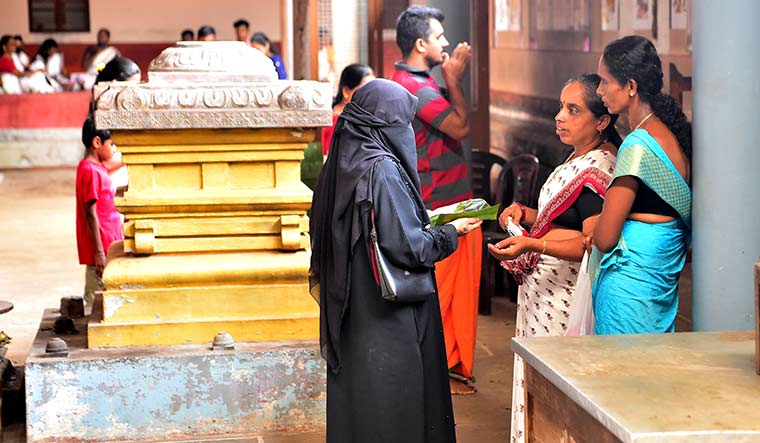It was on a sultry Sunday, before the monsoon kissed the Kerala coast, that I met B. Fathima at the Kumaramangala temple at Bela in Kasargod district. Sunlight glanced off her hijab as she stood, amidst Hindu women, staring at the closed doors of the sanctum sanctorum. As the doors opened, she folded her palms in prayer and then circumambulated the temple.
Fathima is a seller of clothes. “I come here once a month,” she said, explaining her faith. “There is only one God. We call Him by different names.”
On a podium on the left, an Ayilyam puja for serpent gods was being performed. Muslims come here every month on the Ayilyam day of the Malayalam calendar to seek release from sarpadosham or kaal sarp yog (curse of the snake), just as many Hindus in rural Kerala do.
Fathima joined the devotees who sat on a corner to take part in the rituals. Among them sat Kadeja Belenja, reading out verses from a book with the help of a Hindu friend. The puja lasted for an hour.
Belenja said she came to the temple to pray for her son who had an allergy. Her first visit was a year ago, after she saw snakes in her house. The belief is that Ayilyam puja appeases snakes.
Belenja said her son’s condition had improved. “There are some other problems in my family,” she said. “I am sure these will disappear after I use the ginger oil and turmeric given by the priest for a month. God here, like Allah, is powerful.”
Fathima got holy ash from the temple. She said she would dab it on her forehead after namaz. Wouldn’t her family object? “Only my husband knows that I come to the temple,” she said. “I have some illness, and if I am cured, I will offer a lamp to the temple.”
Many Hindus believe that the severest sarpa dosha is due to hurting Lord Subrahmanya or killing a snake. There are 10 types of sarpa dosha. Sri Lankan President Ranil Wickremesinghe prayed at the temple on an Ayilyam day in 2019.
Also read
- Harmony in diversity
- Inculcate mutual respect and reverence for all things divine: Sri Sri Ravi Shankar
- Why Lord Ganesh idols are installed in these dargahs
- Muslims donate land for temple in Madhya Pradesh
- How Ajmer Sharif Dargah empowers seekers of all hues
- On Ugadi, the first visitors to this temple in Kadapa are Muslims
Abu Baker, a social worker from Kasargod, was at the temple on behalf of a female relative who could not come because she was menstruating. He feels blessed every time he visits the temple. “It is the same feeling that I get when I am in a mosque,” he said.
No one knows how old the temple is. “Some say it is 1,000 years old. It was renovated 50 years ago,” said Sudhakar Shetty of the temple committee. The devotees are mostly Hindus, but it is the Muslims who are more ardent. One of the priests, B. Sankaranarayana, said a lot of Muslims visited the temple, though they would not be comfortable talking about it.
Kasargod, bordering Karnataka, has witnessed communal tension in the past. The district collector, Bhandari Swagat Ranveerchand, said, “Communal issues in the district, if at all, are minor in nature. It feels good to know about such religious spots in the district.” Rajmohan Unnithan, MP from Kasargod, said the district had many such temples that attracted people from other religions. “In fact, Kerala,” he said, “is full of such temples and mosques.”
Leaving the temple, Fathima took one more look at the deity—a peaceful look.


